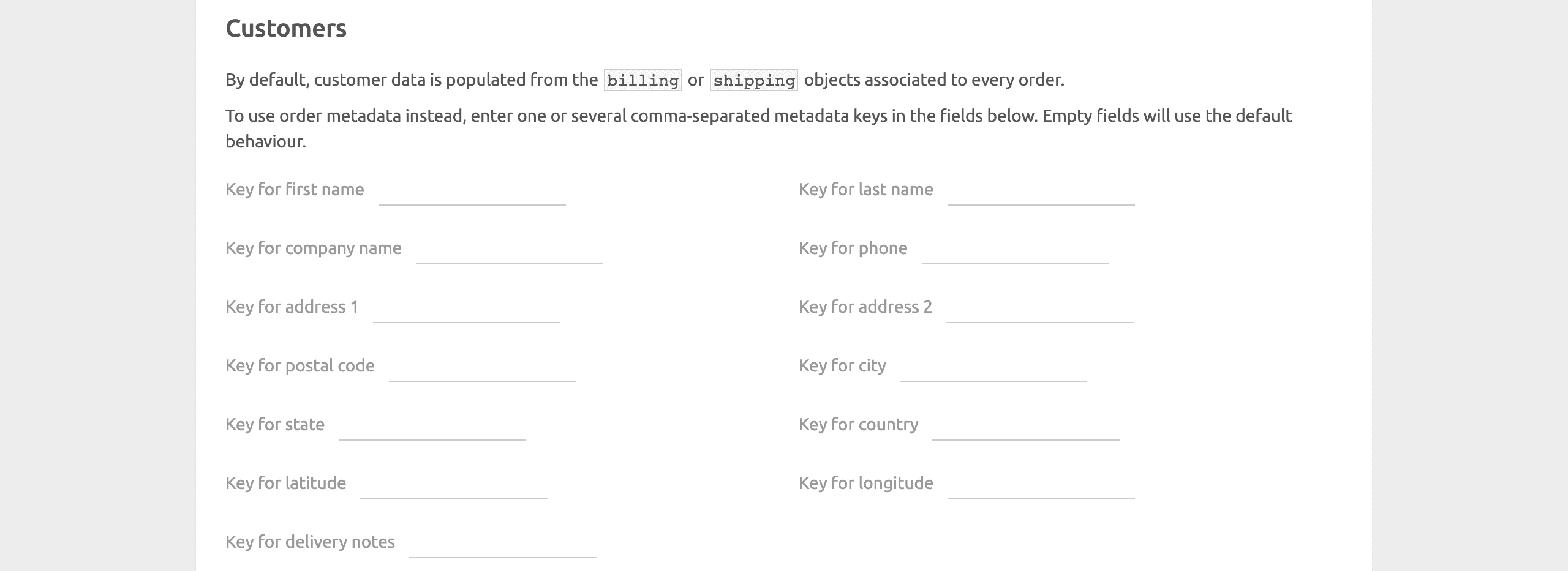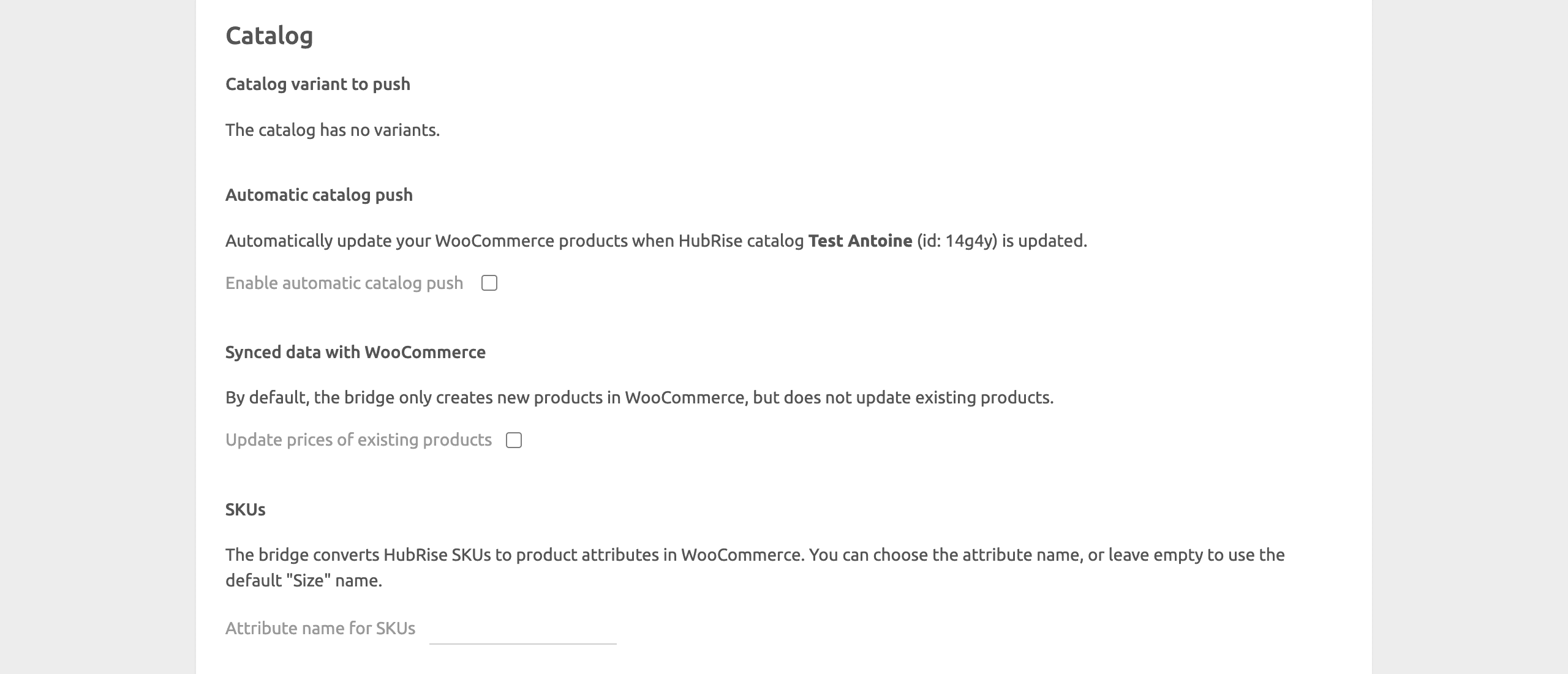- Apps
- WooCommerce
- Configuration

Configuration
The configuration page allows you to customise the behaviour of WooCommerce Bridge based on your preferences.
IMPORTANT NOTE: Due to its very customisable nature, WooCommerce Bridge requires a certain level of technical knowledge to configure. If you are not comfortable with the configuration, place a few different test orders, with various payment methods, and contact us at support@hubrise.com, mentioning the EPOS you are using. We will be happy to help you!
Language

Choose the language to use for generic items such as Delivery charge. These names may appear in your EPOS and in customer receipts.
Orders
The Orders section lets you customise how WooCommerce orders are sent to HubRise.
Order Statuses

IMPORTANT NOTE: In this section, we capitalise the first letter of WooCommerce statuses to make them easier to distinguish from HubRise status names. For example, Processing is a WooCommerce status, while accepted is a HubRise status.
Depending on the payment type, new WooCommerce orders are created with different statuses:
- For credit card payments, the initial order status is
Processing. - For wire transfer payments, the initial order status is
On-hold, and the order requires a manual status change toProcessingwhen the payment is confirmed.
Orders in Processing status are always pushed to HubRise. To also push On-hold orders, tick the Send orders with status "On hold" to HubRise checkbox.
From the HubRise status for new orders drop-down menu, select the HubRise status that you want to assign to new orders coming from WooCommerce. This status applies to Processing orders and, when enabled, On-hold orders.
Then, configure how you want order status updates on HubRise to be reflected on WooCommerce.
For each HubRise status in the section, select the corresponding status that you want to apply in WooCommerce.
For example, you can choose to mark orders as Completed in WooCommerce when they reach the status completed in HubRise.
Service Types

Choose if you want to receive the service type information from the WooCommerce metadata. Your WooCommerce installation must be able to send to HubRise a metadata key and up to three values, corresponding to delivery, collection, and eat-in, in this order.
In the Service type ref code field, enter the ref code for the service that your EPOS expects. Refer to your EPOS documentation on our Apps page to check requirements.
Expected time

Support for expected times in WooCommerce requires a plugin, as WooCommerce does not natively support this feature.
If you do not use expected times, leave the Metadata keys drop-down menu set to None.
Otherwise, you will have to decide between two options for how expected times are encoded by your plugin: One value containing both date and time, or Two values: one for date, one for time.
To determine how your plugin encodes the expected time, place a test order and review the logs on the Orders page. Look for the meta_data field at the topmost JSON level of the order. This is not to be confused with meta_data fields that might be nested under line_items JSON elements. Identify the attribute(s) within this field that contains the expected date and time. If you cannot find the expected time in the meta_data field, contact the plugin developer for support.
Based on the selected option in the Metadata keys drop-down, one or two fields will appear, where you can specify the metadata key name(s) that contain the expected date and time.
If your plugin uses one metadata key, the supported formats are the following:
- ISO 8601. For example:
2021-07-22T12:00:30+02:00. - Unix timestamp. For example:
1642422302.
If your plugin uses two metadata keys, the supported formats are the following:
- The date must be a parsable date or time, for example:
dd/mm/yyyy,yyyy-mm-dd, or an ISO 8601 string where the time part is ignored. - The time must be a parsable time, for example:
hh:mm:ss,hh:mm, or an ISO 8601 string where the date part is ignored.
Misc Order Metadata

In this section, you can specify the metadata keys that WooCommerce uses for the customer notes at the order level. You can enter multiple keys separated by commas.
Order Item Metadata

WooCommerce encodes item information as metadata, which can be further extended by various plugins.
By default, HubRise converts each key-value pair as an option. In this section, you can modify the default behaviour by entering specific metadata:
- In the Metadata key(s) for SKU name field, enter the metadata key that you want to use as the SKU name, for example "Size" with values like "Large" or "Medium".
- In the Metadata key(s) for customer notes field, enter the metadata key that you want to use as the customer notes at the item level, for example "Cooking Preference" with values like "Well Done".
- In the Discarded metadata keys field, enter the metadata key(s) that HubRise should ignore.
In each field, you can indicate multiple keys separated by a comma.
Discounts

Discount ref code is the ref code associated with WooCommerce discounts in your EPOS. Refer to your EPOS documentation on the HubRise website Apps page to know how to handle discounts in your EPOS.
Charges

Delivery charge ref code is the ref code associated with WooCommerce delivery charge in your EPOS. Refer to your EPOS documentation on the HubRise website Apps page to verify.
Payments

The Payments section lets you specify the WooCommerce ID and corresponding ref code for up to 15 payment methods.
The following are typical WooCommerce payment method IDs:
- Cash on delivery:
cod - Check payments:
cheque - Direct bank transfer:
bacs - Stripe payment:
stripe
To find the WooCommerce ID for other payment methods, follow these steps:
- In your WooCommerce back office, click Settings > Payments.
- Click the payment method name to open its details page.
- On the payment method page, look at URL of the page, and note the value after the
section=key. For example, if the URL of the page ishttps://mywoocommercestore.com/wp-admin/admin.php?page=wc-settings&tab=checkout§ion=cod, the ID of the payment method iscod.
To find the ref codes to use, refer to your EPOS documentation on our Apps page.
Multi-site

Configure this section if you support multiple stores from the same WooCommerce website.
Each location must be connected to WooCommerce Bridge and identified by a unique metadata value included in the order payload sent to HubRise. Orders are only forwarded to the location that matches the configured value.
In the Metadata key for multi-site field, specify the metadata key used to identify the location.
In the Value(s) for this location field, specify the value associated with the location. You can specify multiple values separated by a comma.
Customers

The Customers section lets you customise the way that WooCommerce sends the customer information to HubRise. By default, customer data is sourced from the shipping address, or the billing address if the shipping address is missing.
Enable Always use the billing address to use the billing address, even if the shipping address is present.
If you use plugins that store customer information in metadata, use the Key for (...) fields to associate metadata keys with customer fields in HubRise. To help you identify the correct metadata keys, place some test orders from your WooCommerce store and check the order logs in the Latest operations tab.
Catalog

Catalog Variant to Push
Catalog variants give you the flexibility to disable specific items or adjust prices for your WooCommerce website. For more information, see Catalog Variants in our Catalog Manager online documentation.
If your catalog includes variants, you have the option to select which one to use. When (none) is selected, the default items along with their standard prices are used. If your catalog has no variants, the menu will be hidden and a message will be displayed.
Automatic Catalog Push
If you want to automatically update your WooCommerce products every time your HubRise catalog is updated, tick the Enable automatic catalog push checkbox.
Synced Data with WooCommerce
By default, when you push a catalog into WooCommerce, WooCommerce Bridge creates new products in WooCommerce but does not update existing products. To update prices of existing products, tick the Update prices of existing products checkbox.
SKUs
By default, WooCommerce Bridge converts HubRise SKUs to product attributes in WooCommerce with the label "Size".
To use a different label for your attributes, for example "Colour", enter the value in the Attribute name for SKUs field.
Inventory

The Inventory section lets you configure automatic updates of the WooCommerce inventory counters when the HubRise inventory changes. To enable this feature, tick the Enable automatic inventory push checkbox.
Save the Configuration
To save the configuration, click Save at the top of the page.
Reset the Configuration
If you need to reset the configuration, click Reset the configuration at the bottom of the page.
IMPORTANT NOTE: Resetting the configuration will instantly disconnect the bridge from WooCommerce.
Resetting the configuration does not delete the operation logs displayed in the main page.